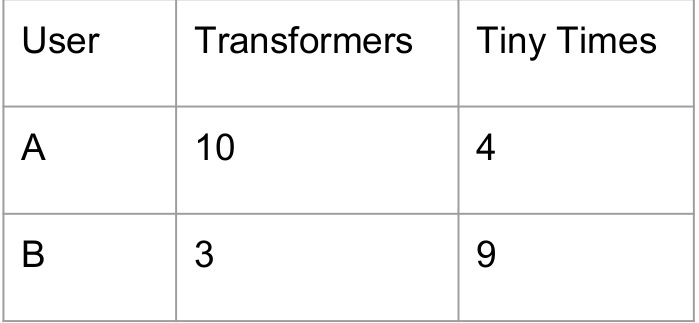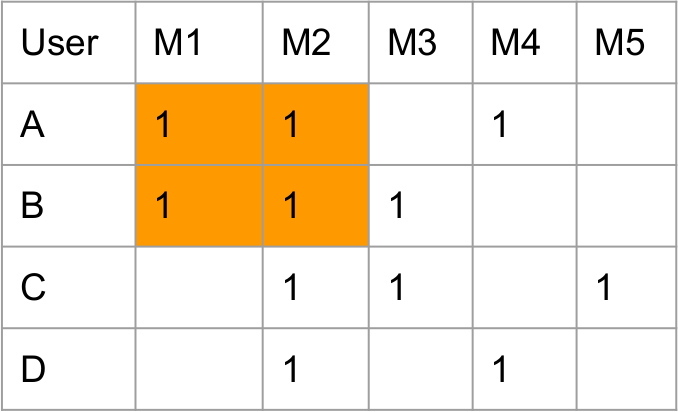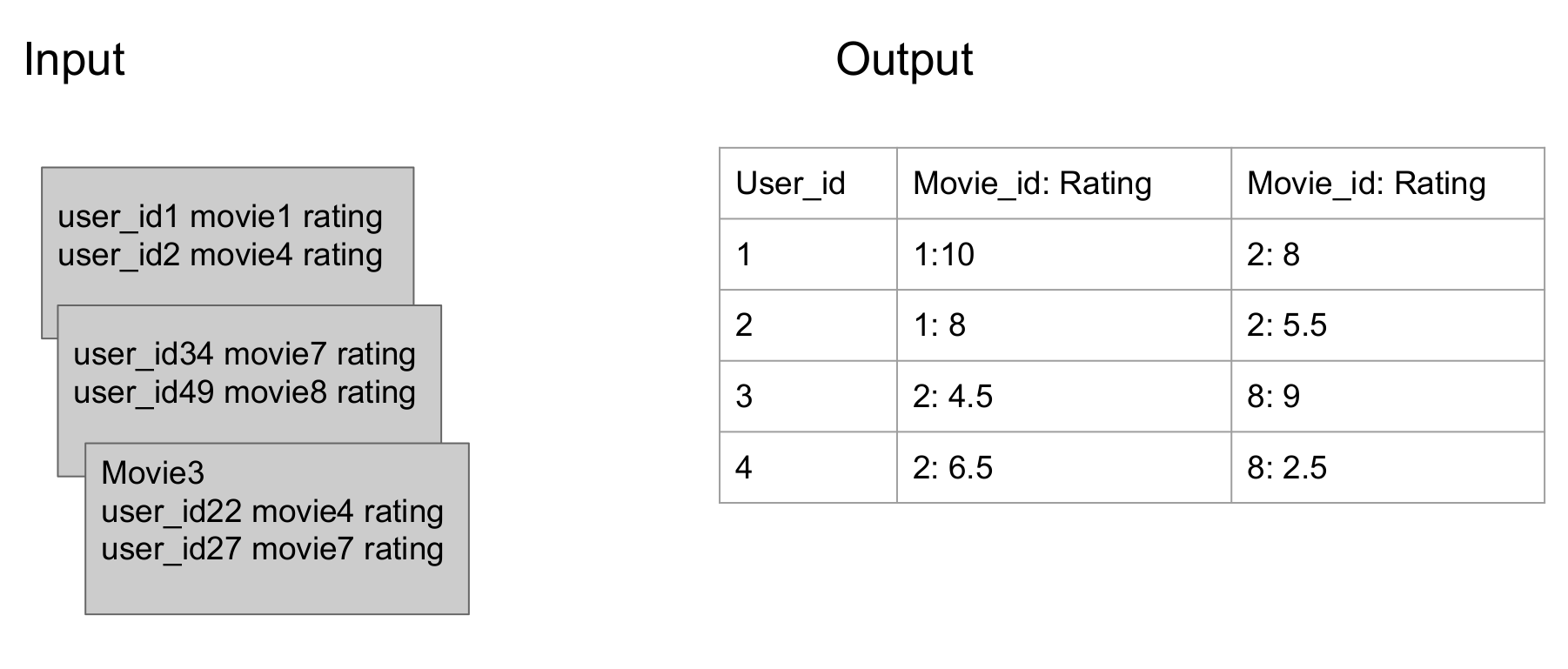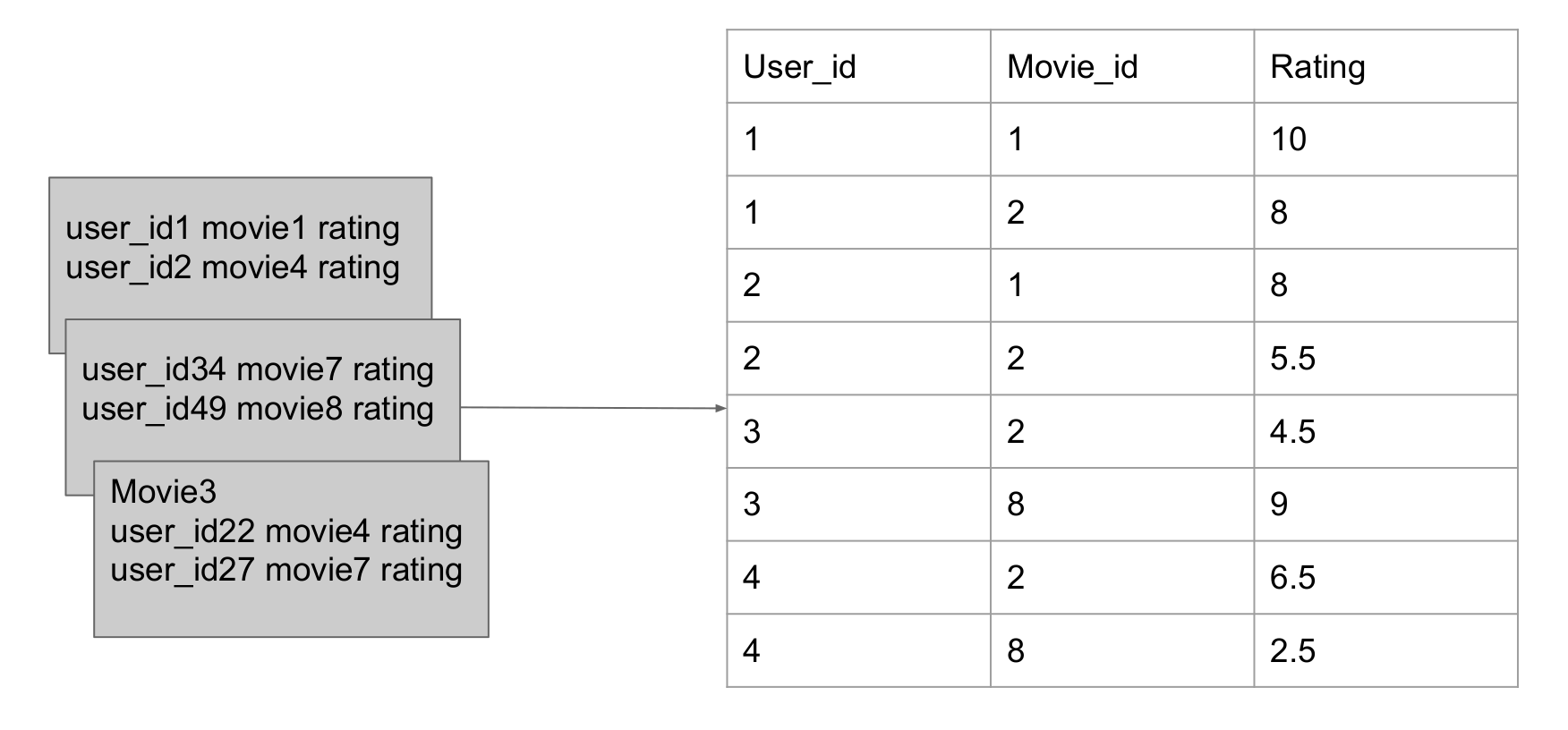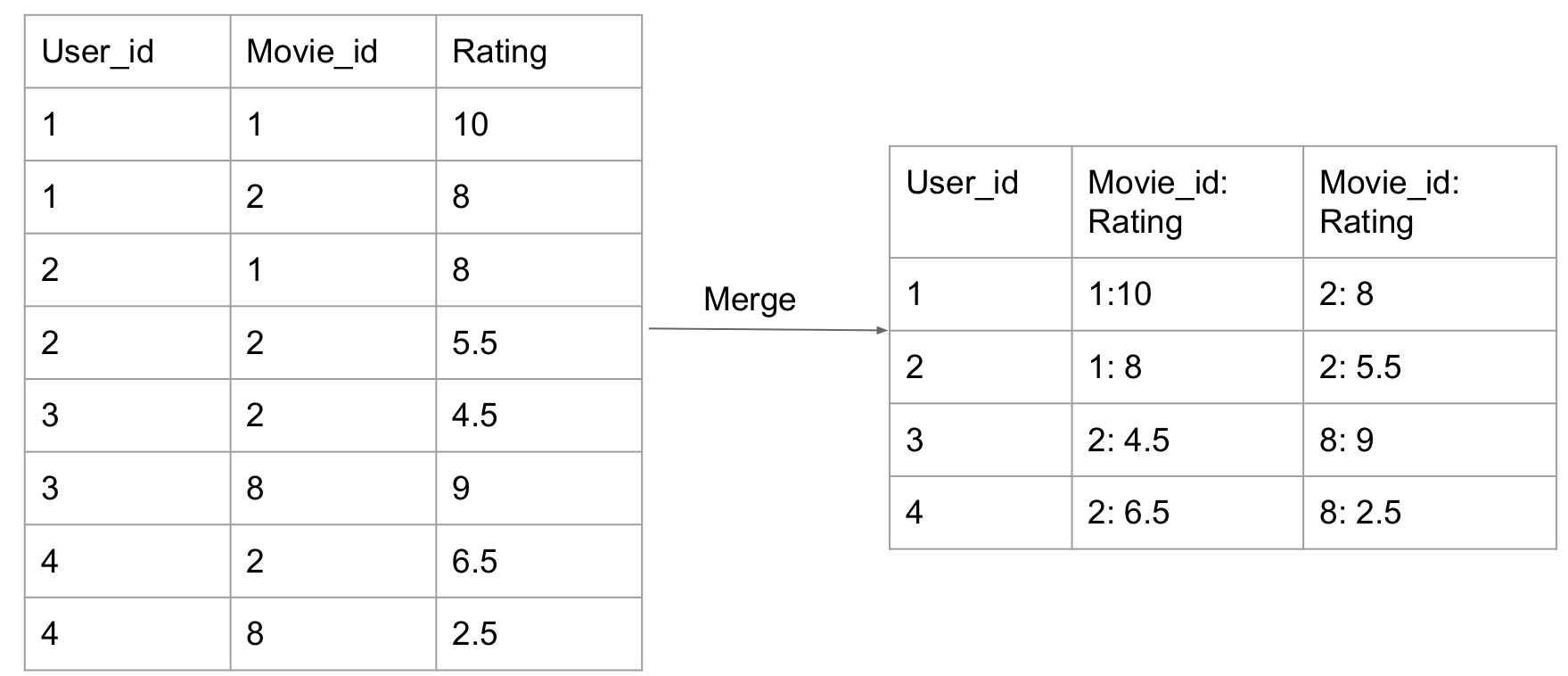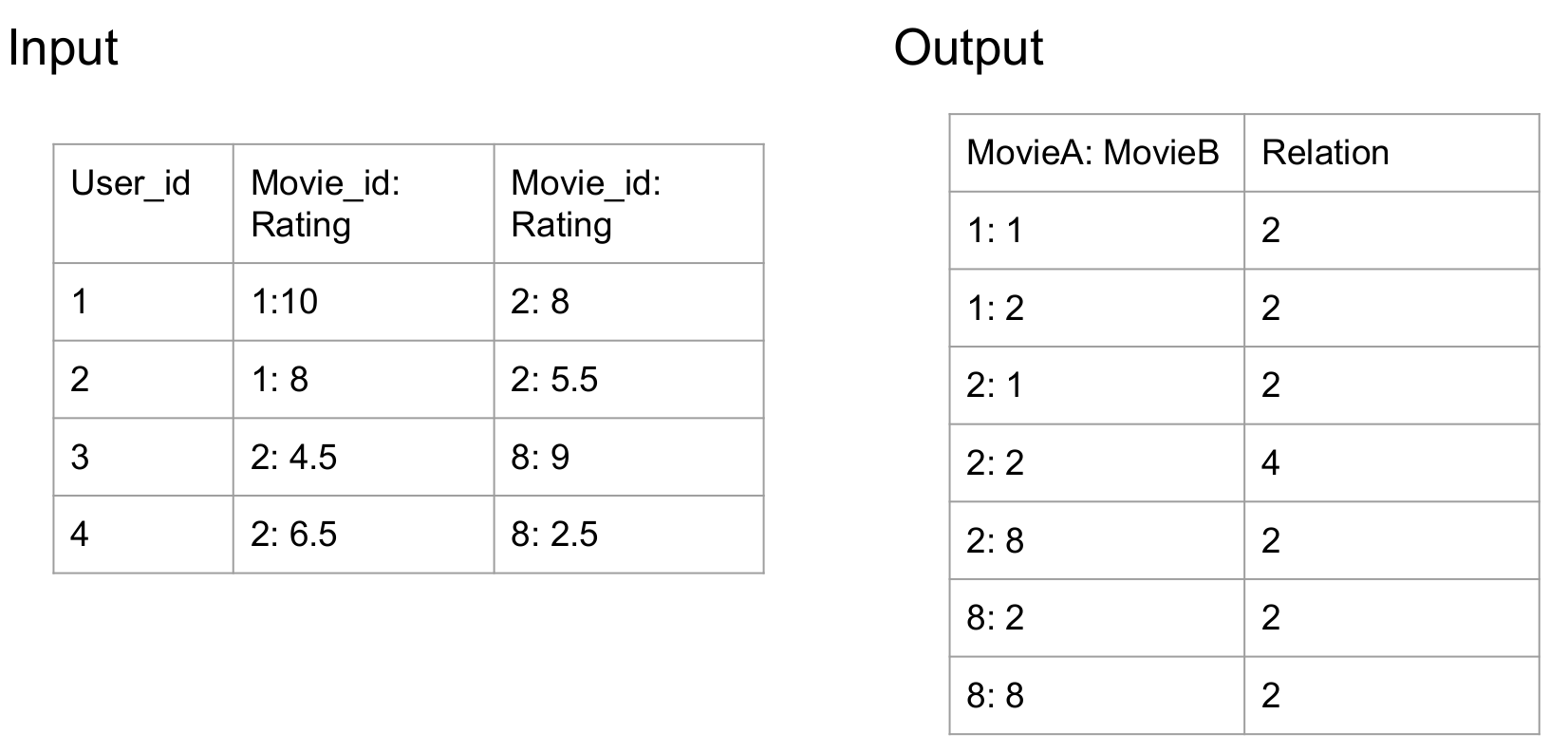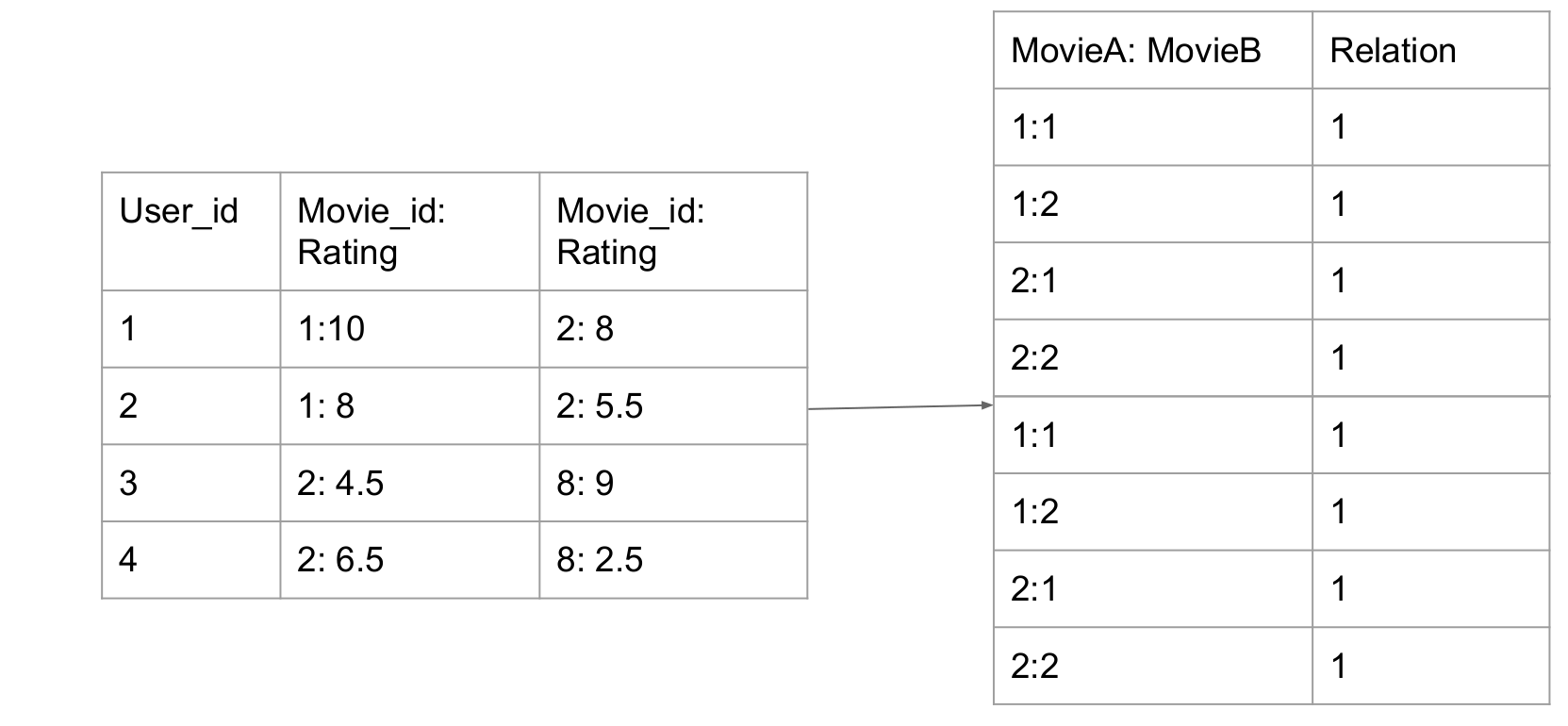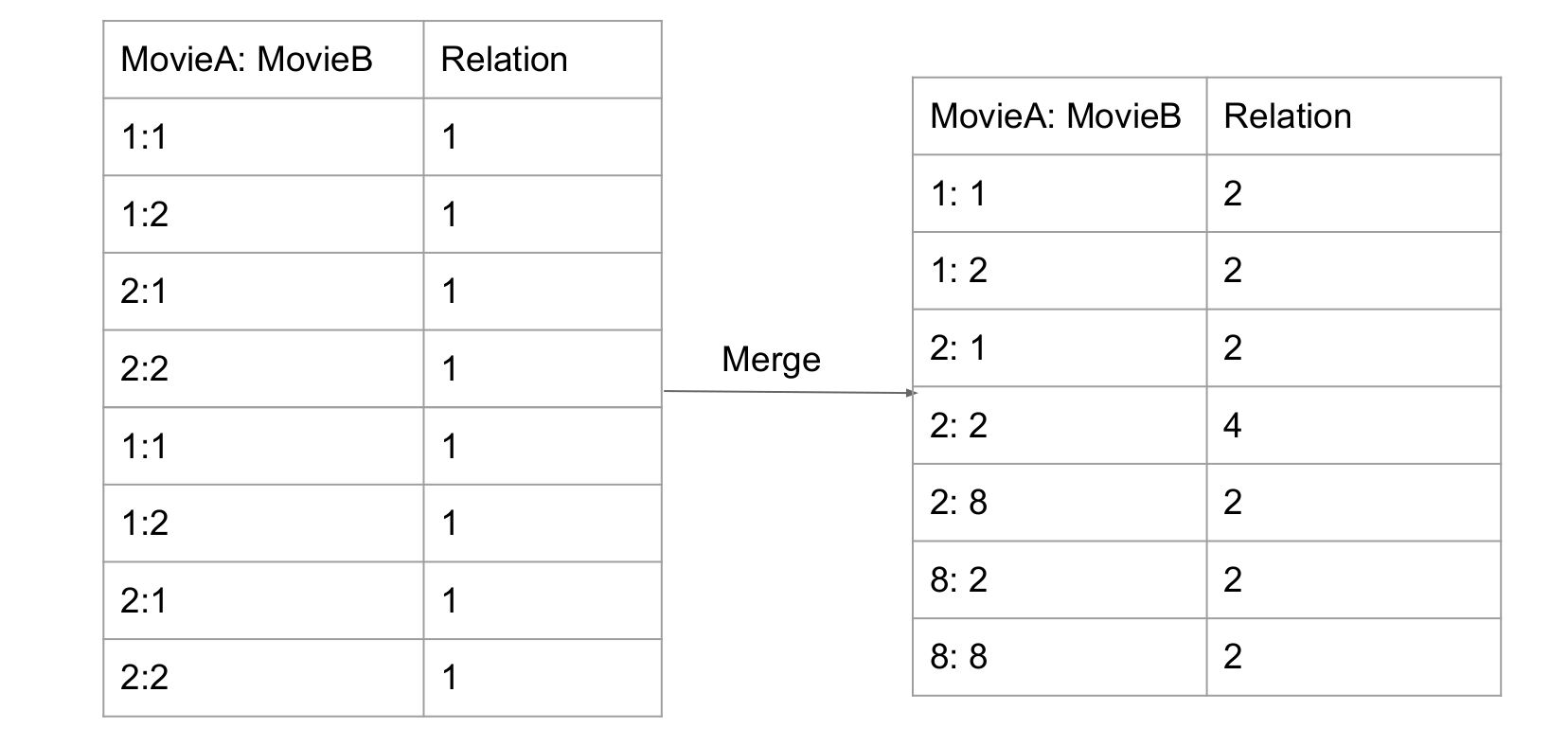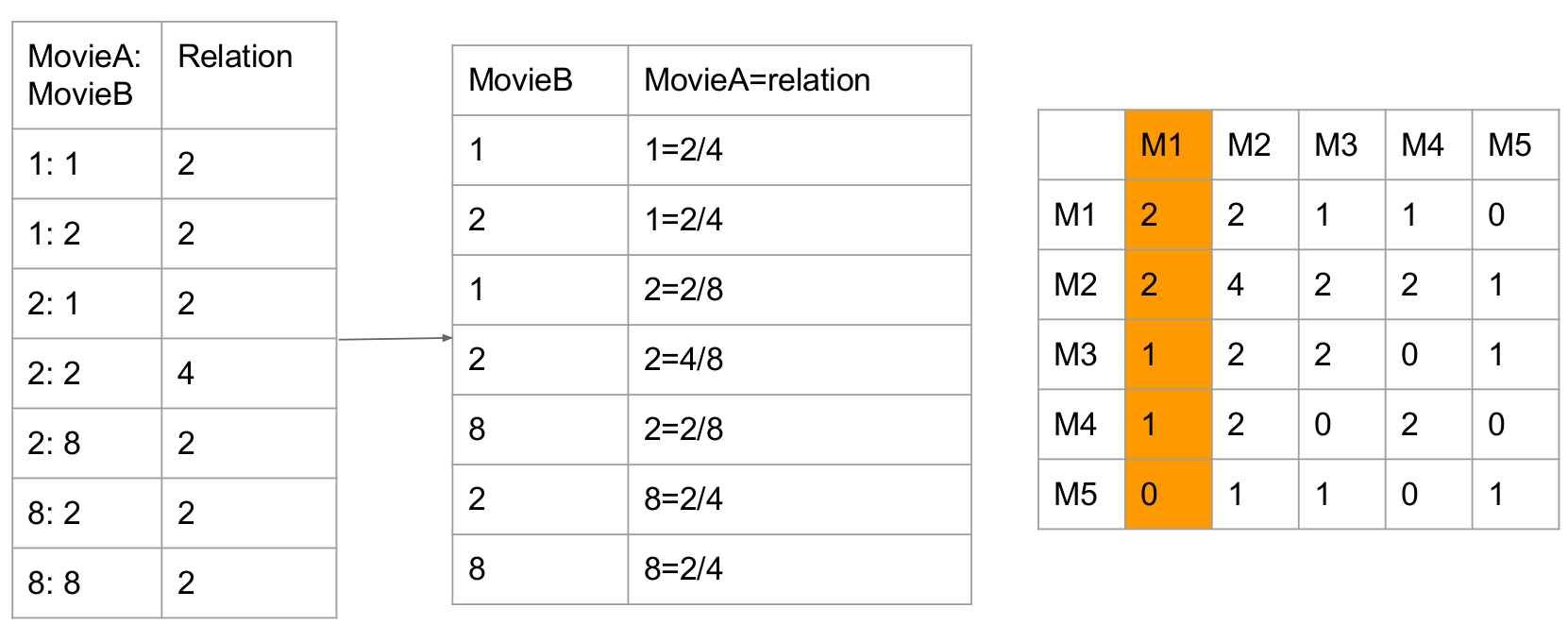Collaborative Filtering
-
User-Based CF
- A form of collaborative filtering based on the similarity between users calculated using people's ratings of those
items
 For different users, initialize their rating matrix for several movies.
And if we found userA is similar to UserC, we can recommend Movie4 to UserC because similar UserA likes this
movie as well.
For different users, initialize their rating matrix for several movies.
And if we found userA is similar to UserC, we can recommend Movie4 to UserC because similar UserA likes this
movie as well.
- A form of collaborative filtering based on the similarity between users calculated using people's ratings of those
items
-
Item-Based CF
- A form of collaborative filtering based on the similarity between items
calculated using people's ratings of those items
 For different movies, their similarities are calculated by people's ratings. So based on their ratings, the Movie1
and Movie3 are more similar with each other than Movie2. So even if UserC who does not watch Movie3, but MovieC
is similar to Movie1 which UserC gave a high rating, we can recommend this movie to UserC based on item-based-CF
For different movies, their similarities are calculated by people's ratings. So based on their ratings, the Movie1
and Movie3 are more similar with each other than Movie2. So even if UserC who does not watch Movie3, but MovieC
is similar to Movie1 which UserC gave a high rating, we can recommend this movie to UserC based on item-based-CF
- A form of collaborative filtering based on the similarity between items
calculated using people's ratings of those items
-
The main challenge is how to calculate the similarities between items or users
-
Why choose Item-Based-CF?
- Because the number of users is way too larger than the number of movies. If we try to use user-based-cf, we will have to calculate the similarities between users which is quite complex and may not be a good model.
- Item (similarities between items) will not change frequently which can simplify the amount of calculation
- It is more convincing to use users' own historical data instead of recommending users with something by someone else.
-
How to calculate similarity of items?
- Build co-occurrence matrix
- Build rating matrix for each user
- Matrix multiplication to get the recommendation list
-
Co-occurrence Matrix
-
When use Item-Based-CF: first to consider how to describe the relationship between different items(movies)
-
Based on user's profile:
- Watching history: con: some users watch some many movies which are not quite similar.
- Rating history
- Favorite list
-
Based on movie's info
- Movie category
- Movie producer
-
-
Rating history:
- Assume all the users are good user who rate by themselves
- If one user rated two movies, both two movies are related
- Rating this action somehow shows the interests or full impression of users
-
Co-occurrence matrix:
-
Definition: A co-occurrence matrix is a matrix that is defined over an image to be the distribution of co-occurring pixel values (grayscale values, or colors) at a given offset.
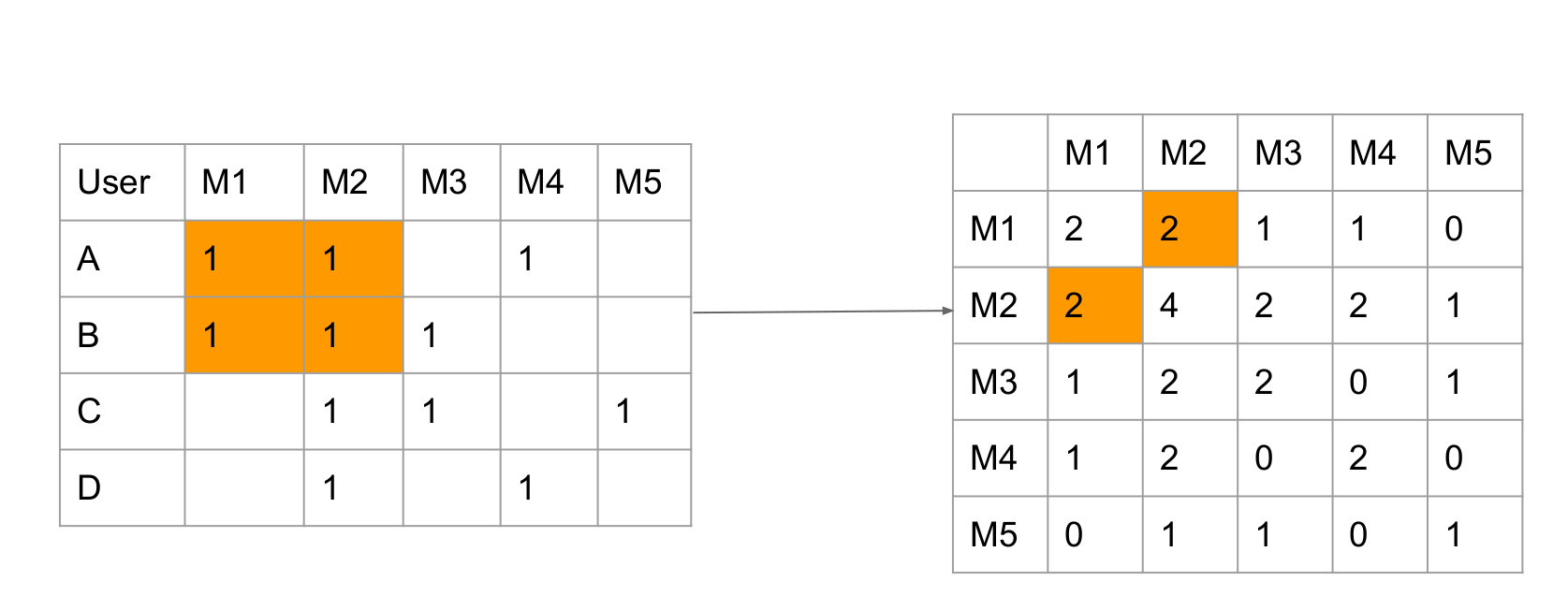
-
The assumption is if a user watched both two movies, the two movies are related. And when this action keeps repeating, the relation (similarity) of this two movies are growing higher and higher.
In the image, userA and userB both rated M1 and M2.
So value(M1, M2) = value(M2, M1) = Count(x_M1 && x_M2) = 2 (x_M1 means one userX rates M1)The left matrix is the rating matrix of different users on different movies. (default score is 1)
The right matrix is co-occurrence Matrix
The diagonal of co-occurrence matrix represents the total watched times of this movies
-
-
Rating Matrix
-
How to tell the difference between movies towards each user?
Different users may have different score criterion on the same movie. This could affect the recommendation toward other users. So it is necessary to find the movie the user likes first, and find the similar movies from the co-occurrence matrix and then do the recommendation.
-
Rating matrix: showing the preference of user on the rated movies
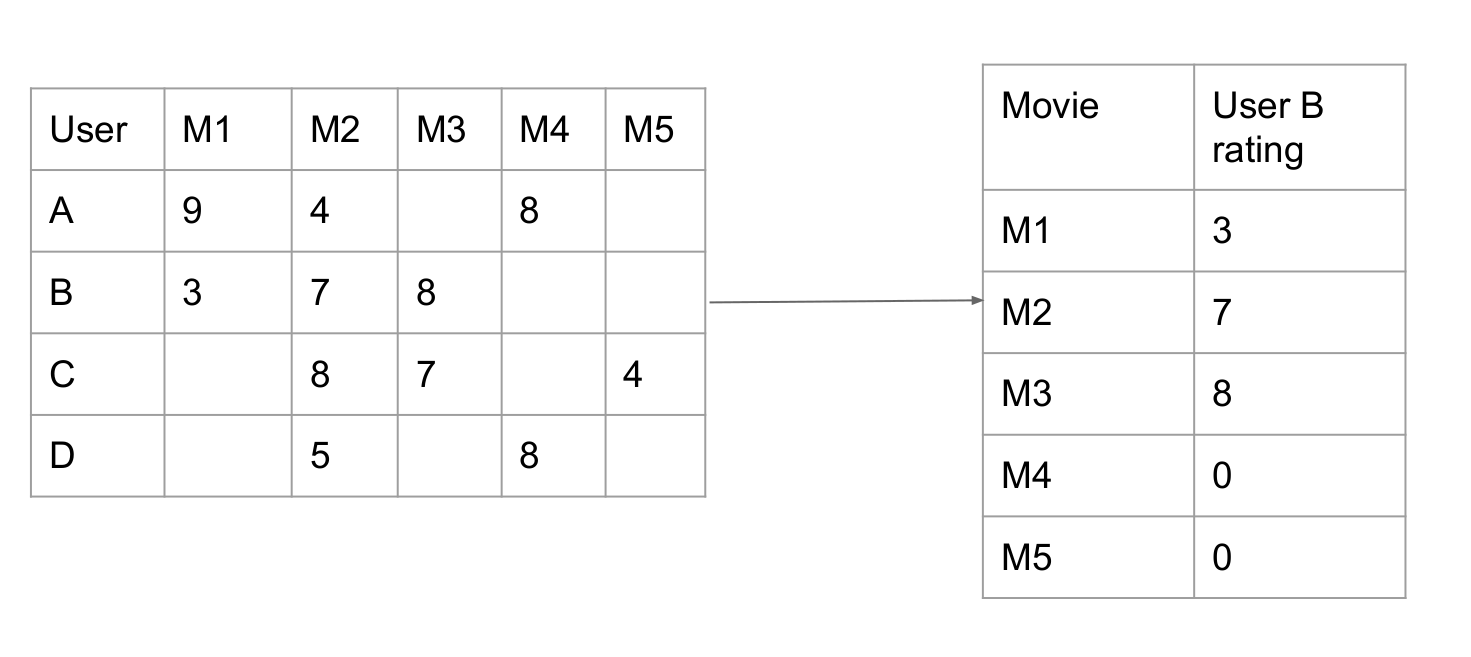 But it should NOT put M4 and M5 with 0 because UserB has not watched it. Instead, put
userB's average score based on total scores userB rated / total movies userB watched
will make sense
But it should NOT put M4 and M5 with 0 because UserB has not watched it. Instead, put
userB's average score based on total scores userB rated / total movies userB watched
will make sense
-
-
Normalization
-
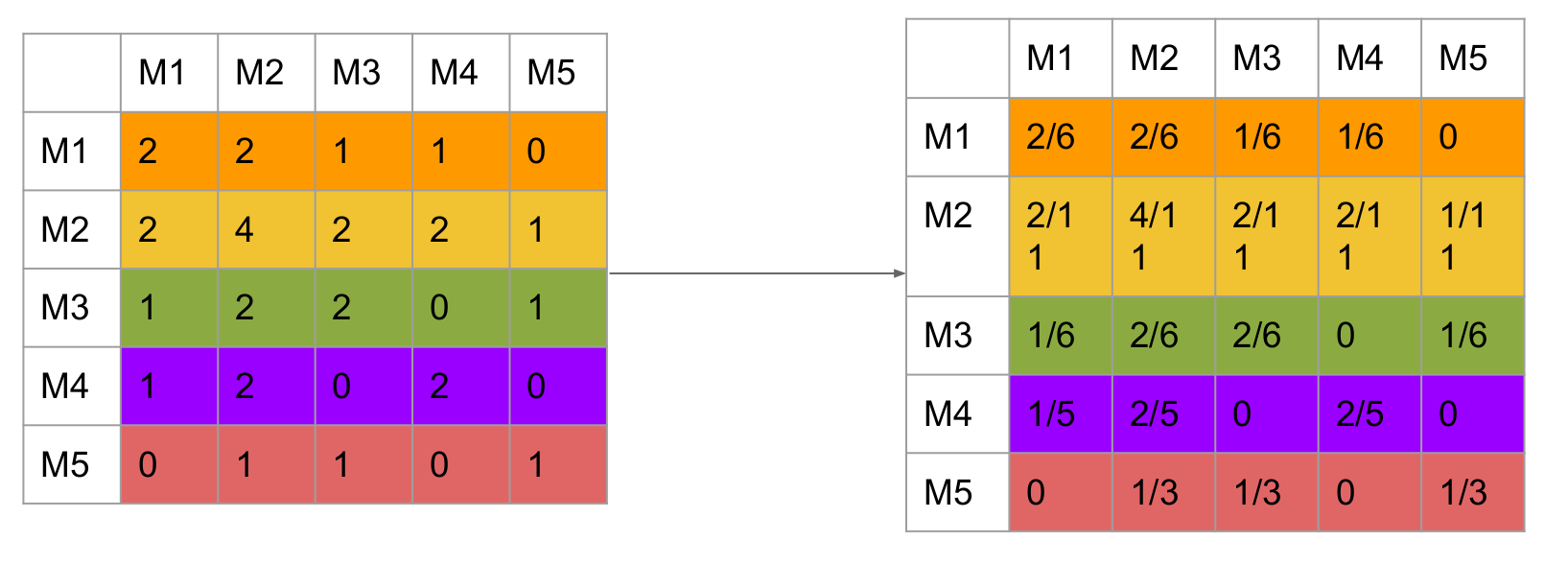 The original co-occurrence matrix cannot precisely describe the similarity between two movies because the
The original co-occurrence matrix cannot precisely describe the similarity between two movies because the
denominator is different. Assume value(M1, M2) is 5 and value(M1, M3) is 3. However what if M2 has relationship with other 1000 movies and M3 only has relationship with other 5 movies. In this way, the M1 and M3 should be more related. This is the reason we apply normalization to make the similarity comparison on the same standard. -
Each row of normalized matrix represents current movie's similarities with other movies which are both rated by one user. In other words, each row means the similarity probabilities between M_x and all other movies.
-
Each entry of the matrix represents the conditional probability. (M1, M2) means given rated M1, what is the probability for this user to also rate M2.
-
P(A|B) != P(B|A) explains why probability on diagonal are not equal
In this way, the co-occurrence matrix becomes asymmetrical. value(M1, M2) = 2/6, value(M2, M1) = 2/11 This can be explained as M1 was not that popular so people who watch both M1 and M2 are even less. So M1 to M2's similarity is bigger than M2 to M1's similarity
-
-
Result List by Matrix Multiplication
- Co-occurrence Matrix x Rating Matrix
- The principle is if some user has lower rating on M1, then this rating will reduce the weight on the
movies which have more similarities with M1 and furthermore affect the recommendation result on the
movies this user has not yet watched.
- Example: for For M4 and UserB rating matrix. Multiplication is made by row x column. So the meaning is: for (M4, M1) = 1/5, for unseen M4 of UserB, it has 1/5 for UserB to rate 3 score. Likely, 3/5 probability for UserB rate 7 score on M4. M4 and M3 are not similar, so cannot infer the score UserB may rate for M4 based on M3.
- Unwatched movie's default score cannot be set as 0. Otherwise this will affect the result list
(UserB rate high score on M2 however score for M2 in result is lower than original score). The reason
is UserB did not watch M4 and M5 and we intuitively set it as 0 so this could make calculation on M2
missing some part of weights. And this problem can be avoided if the data is so huge which could fade
away the effect of some NULL entry in the rating matrix.
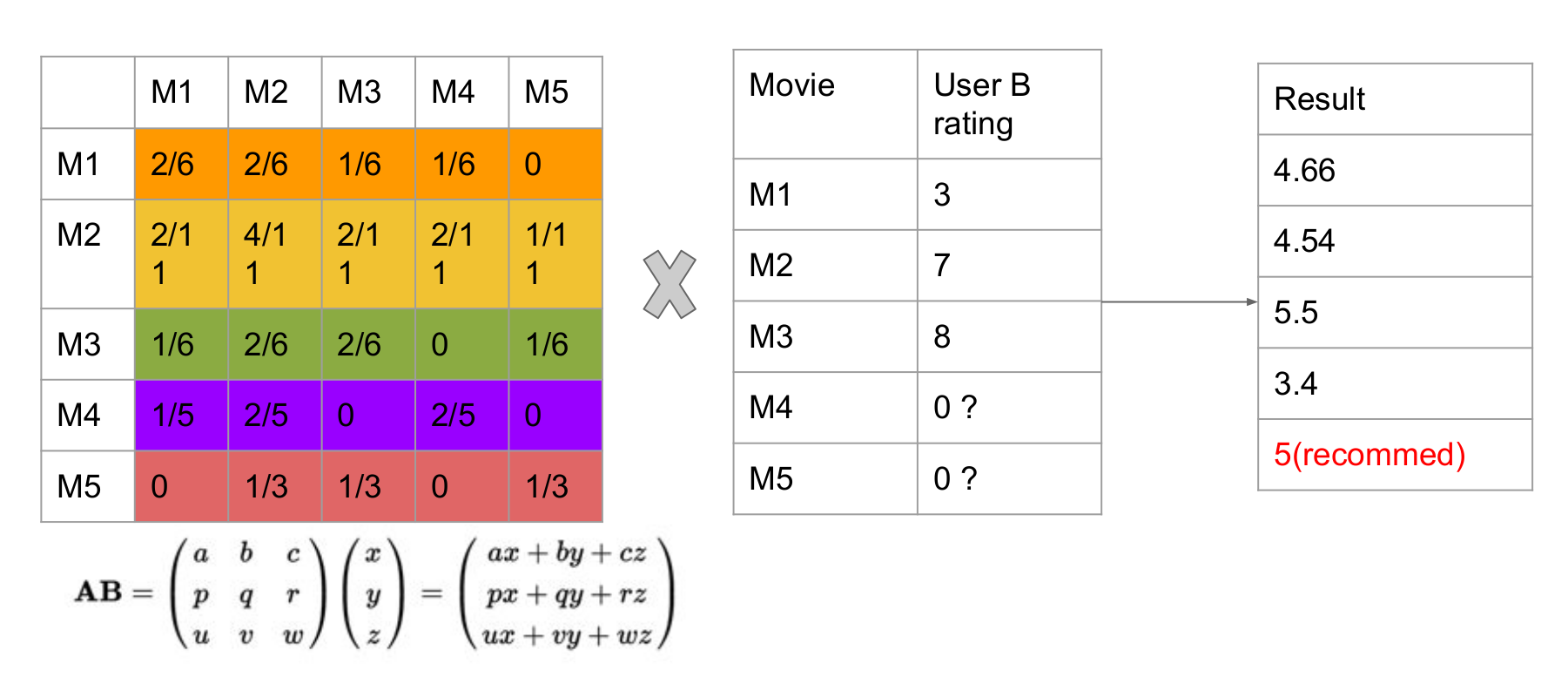
-
-
Raw Data Storage:
-
First MapReduce Job: data preprocessing
-
Jobs ahead:
- Normalize the Co-occurrence Matrix
- Get the Rating Matrix
- Multiply co-occurrence matrix and rating matrix
- Generate recommendation list
-
Challenges:
-
Mapper can once read input from one file. So when Mapper reads one row from Co-occurrence Matrix, there is nothing from another matrix. So the multiplication cannot happen in this way.
-
One feasible method is to restore Co-occurrence Matrix into a real matrix and cache it in the memory. When Mapper reads one row from Rating Matrix, get data of Co-occurrence Matrix from the memory.
-
Do the multiplication and output to the Reducer.
- Read the Co-occurrence Matrix and restore in the memory (store in HashMap in setup())
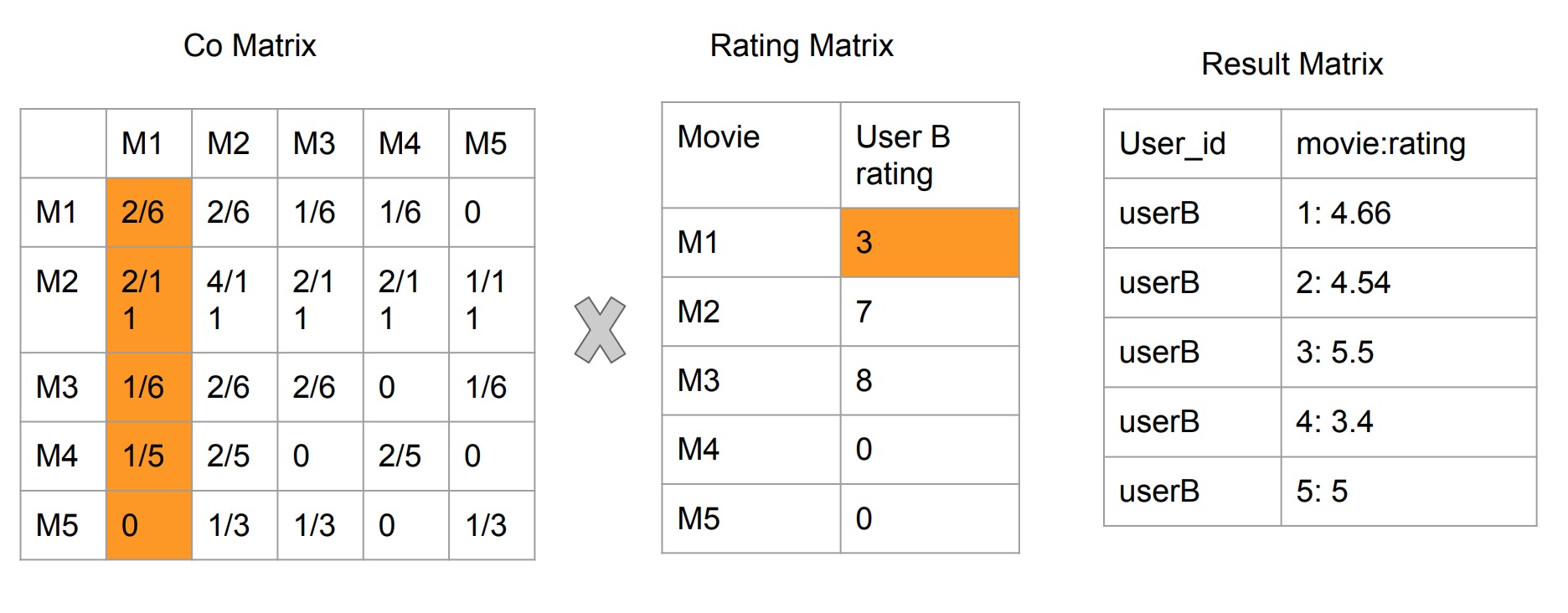

- Read the Rating Matrix
- Do the multiplication
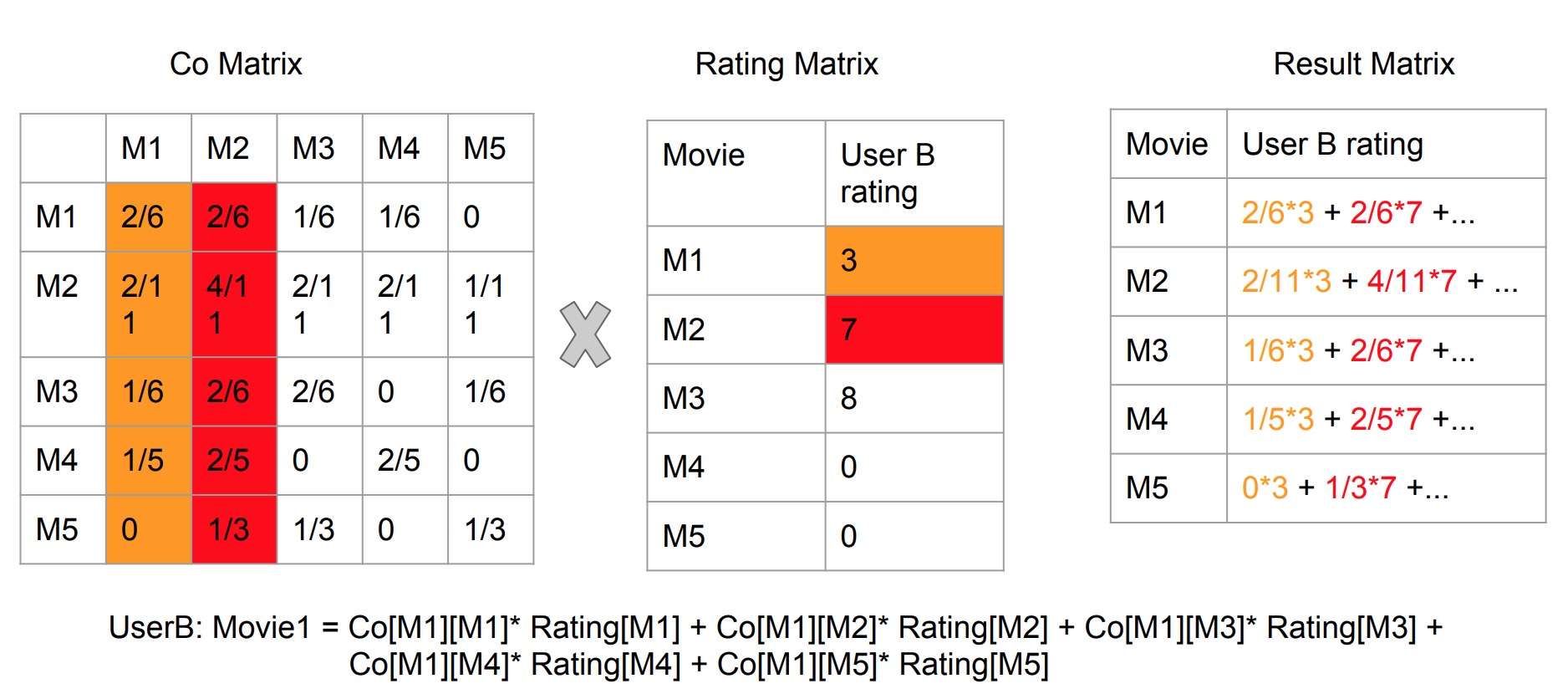
- Why store a column in HashMap instead of a row is:
- Co-occurrence Matrix rows and columns are symmetrical before normalization
- Mapper job is to calculate corresponding entry multiplication. So when reads userB rating on M1 (3), it should be multiplied with 2/6, 2/11..., when reads userB rating on M2 (7), it should be multiplied with 2/6, 4/11... And let the reducer do the sum job like we do in real matrix multiplication process (row x column)
- Why store a column in HashMap instead of a row is:
One potential problem is when the matrix is too huge, it would cause OutOfMemoryError
- Read the Co-occurrence Matrix and restore in the memory (store in HashMap in setup())
-
DataDivider -> CooccurrenceMatrixGenerator -> Normalization -> MatricesMultiplication -> RecommendationListGenerator
During matrices multiplication process, instead of storing the whole Cooccrruence Matrix in the memory in Version 1,
we use Hadoop ChainMapper to read CooccurrenceMatrix and RatingMatrix in parallel.
Each time when reading data from HDFS, first mapper reads an entry in the cooccurrence matrix and second mapper reads
one line from rating matrix.
During reduce process, distinguish two data by its identifiers (":" or "=") and multiply all data from cooccurrence
matrix and one line from rating matrix with same key (movieB_id) and output them.
At last, during recommendation list generator mapper process, filter out watched movies records,
sum up ratings and convert movie_id to movie_title.
The same as Version 1 but avoid potential OutOfMemoryError
1 Book Club:1.86
1 The Seagull:1.55
1 Leon:1.8
1 Three Idiots:1.25
2 The Seagull:1.55
2 Leon:2.05
2 Three Idiots:1.0
3 Death Pool:1.42
3 TAG:1.44
3 Leon:1.65
4 Death Pool:2.85
4 The Seagull:2.6
4 Three Idiots:2.38
5 Three Idiots:2.88
